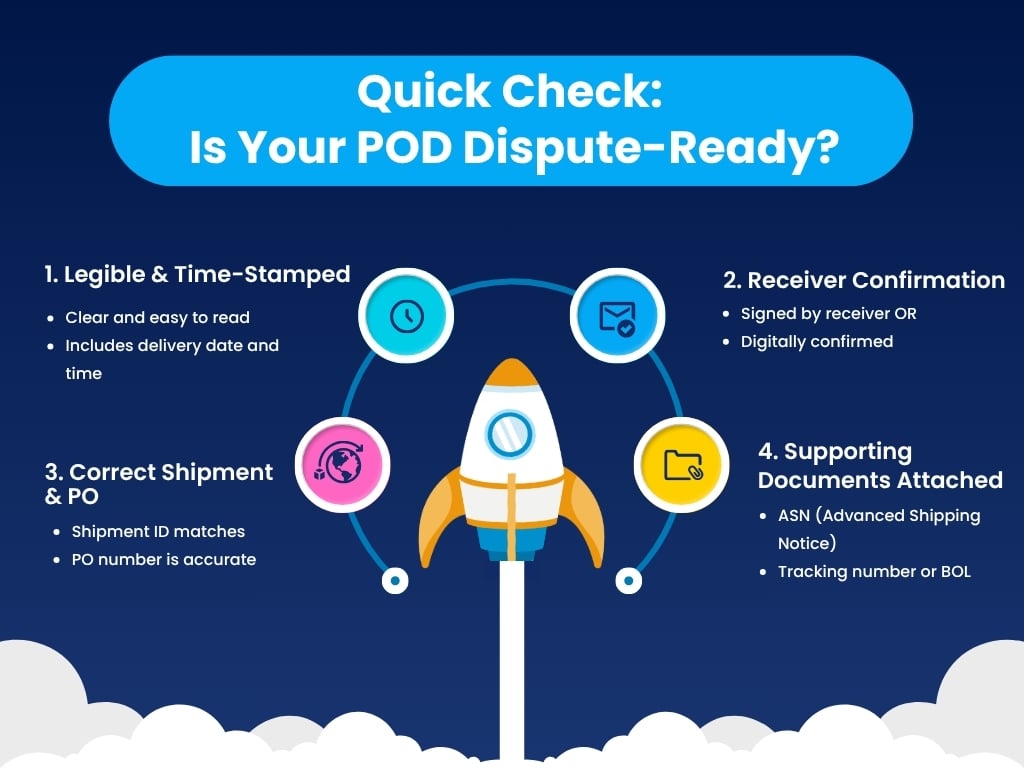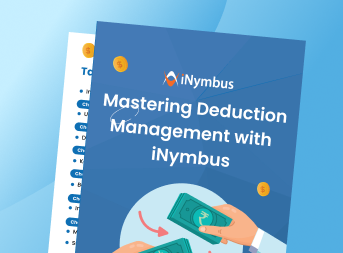 Providing proof isn’t optional. It’s essential.
Providing proof isn’t optional. It’s essential.
Without the right documentation, nothing can be verified or finalized. In retail deduction disputes, proof of delivery (POD) is more than a detail. It’s your defense.
If you can’t show that the item arrived on time and in full, you may lose the payment. Retailers are tightening requirements. Many now ask for digital proof uploaded directly to their portals. A missing or late POD is one of the top reasons claims are denied.
Avoid that loss. This guide covers what proof of delivery really means, how to upload it, and how automation tools like iNymbus help vendors handle PODs faster. You’ll also learn how electronic proof of delivery (ePOD) is shaping the future of dispute resolution.
What Does Proof of Delivery Mean?
Proof of Delivery (POD) confirms that the recipient received the shipment in full and on time. The delivery person hands the shipment over, and the receiver signs the POD to confirm delivery. A complete POD typically includes:
- The delivery date
- The recipient’s name and signature
- Shipment contents or tracking info
- Store or distribution center details
Traditionally, this proof came in the form of paper. But now, most retailers prefer digital proof of delivery or electronic proof of delivery (ePOD). With ePOD, vendors upload the document directly to retailer systems. This digital approach makes validation faster, easier, and more scalable.
💡 Pro Tip: Always support your POD with documents like Advance Ship Notices (ASNs), the bill of lading, and tracking data. These extra documents help clear confusion and strengthen your case during a dispute.
Why Proof of Delivery Matters in Deduction Disputes
Retailers submit claims for deductions. They do this when they believe the carrier did not deliver an item properly. This can happen even if someone actually delivered the item. Without a valid Proof of Delivery (POD), you may struggle to challenge the claim and recover the money.
Walmart might use Code 22 (Merchandise Not Received) to reduce payment if it thinks the carrier missed the delivery. Amazon often files shortage claims for similar reasons. These disputes usually stem from missing or late documentation, not actual delivery failures.
Your POD is your defense. It proves the delivery happened, the goods arrived, and someone accepted them.
If you can’t find that proof quickly, you will waste hours going through paperwork. You will also spend time contacting carriers and losing valuable time.
Real Example: One iNymbus client processed over 1,000 deduction claims in under a week, clearing a full month’s backlog. That shift from manual to automated uploads dramatically increased claim resolution speed and efficiency.
Step-by-Step: How to Upload Proof of Delivery
If you still handle PODs manually, follow these steps to do it right and avoid costly errors:
Step 1: Gather Your Shipment Info
Collect these details before you upload anything:
- Carrier name
- Tracking number
- Shipment ID
- Delivery date
- Destination store or distribution center (DC)
Step 2: Locate or Scan the POD
Make sure the document is clear, time-stamped, and signed. For digital proof of delivery, use high-quality scans or direct exports from your transportation system.
Step 3: Log into the Retailer Portal
Use the appropriate vendor platform:
Each portal has slightly different layouts, but all require you to locate the deduction case.
Step 4: Find the Deduction or Dispute
Navigate to the specific chargeback or dispute section related to the delivery.
Step 5: Upload the POD
Follow the portal’s file requirements (usually PDF or image). Name the file clearly, linking it to the shipment ID or PO number.
Step 6: Submit and Track
After uploading, confirm submission and monitor the case for updates. Keep a record of the timestamp for your upload.
Imagine this: You finally got the delivery out. The customer receives it. Yet two weeks later, bam — a deduction appears. Why? Missing POD.
Avoid this mess by uploading the proof immediately after delivery.
The Role of Digital Proof of Delivery in Advanced Transportation
Advanced transportation systems rely heavily on digital proof of delivery to create a paperless, real-time supply chain. PODs now come directly from drivers using mobile devices or logistics platforms that capture geolocation and timestamps.
When paired with Advance Ship Notices (ASNs) and transportation management systems (TMS), this digital proof:
- Eliminates delays in communication
- Reduces human error
- Enhances visibility for both vendors and retailers
- Speeds up the deduction dispute resolution
Many retailers consider proof of delivery for advanced transportation a compliance requirement. Missing it often triggers auto-deductions.
Resolve POD Deductions at Scale with iNymbus Automation
Manual uploads might work for a few shipments, but they won’t scale as your business grows. If you manage thousands of deliveries a month, uploading each proof of delivery (POD) by hand takes time and increases the chance of error.
iNymbus solves this.
We automate your entire deduction recovery process by:
- Pulling shipment and delivery data from your ERP or system
- Fetching and attaching digital PODs
- Uploading everything directly to Amazon, Walmart, Target, and other portals
- Retrying failed uploads automatically
- Tracking response statuses in real time
“With iNymbus, our POD uploads and dispute responses went from days to minutes.” — iNymbus Client, 2024
On average, iNymbus clients resolve disputes 3 to 5 times faster and recover up to 90 percent more deductions, including those caused by missing or mismatched PODs.
Quick Check: Is Your POD Dispute-Ready?
Before uploading your POD, make sure it checks all the boxes:
- ✔ Is it legible and time-stamped?
- ✔ Is it signed or digitally confirmed by the receiver?
- ✔ Does it match the correct shipment ID and PO number?
- ✔ Are supporting documents like ASNs or tracking info included?
If the answer is “yes,” you’re ready to submit. If not, fix it before it causes a deduction.

POD Mistakes
Timely, accurate proof of delivery isn’t just a formality; it’s essential for getting paid. If you ignore or delay this step, retailers will keep deducting funds, and you’ll struggle to recover them.
The good news? You don’t have to handle this manually anymore.
A clean, automated POD process saves time, reduces errors, and protects your bottom line.
Let iNymbus handle the uploads and automate dispute resolutions. This will free your team to focus on what matters most: growing your business.
The Future Is Automated
By 2026, experts predict that 85% of B2B vendors will rely on automated deduction software. Manual uploads simply can’t keep up as order volumes grow and retailer requirements become more complex.
Ready to move faster, recover more, and stop letting POD disputes drain your profits?
Book a demo with iNymbus today and start automating your proof of delivery and deduction recovery process.
